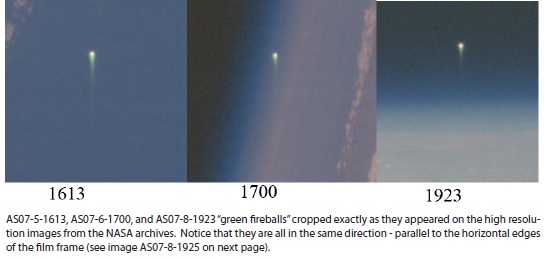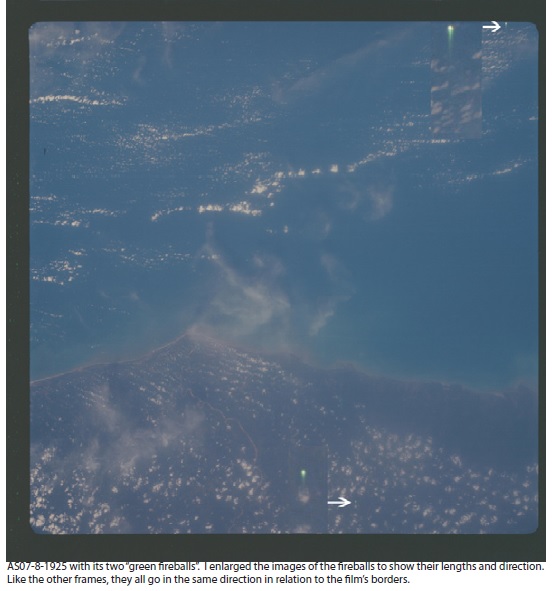.
Anthony Bragalia, as is his custom, wrote another sensationalist style piece on his blog, which discussed the green fireball phenomenon. Some of the evidence he presented had little to do with the green fireball observations of the late 1940s other than somebody recorded green lights in the sky. However, there were two claims that Mr. Bragalia listed that intrigued me:
- Revealed here are remarkable images (recently found buried within NASA space footage archives) of a Green Fireball that seems to “follow” our astronauts
- Striking and exceeding rare film has been located, also taken from space, where one can vividly see the strange Green Fireballs doing the impossible: exiting the earth’s atmosphere rather than entering it
All of these comments had to do with Bragalia “finding” two images that showed what appeared to be green fireballs moving across the frame. One appeared to be even exiting the earth’s atmosphere! Bragalia would imply that these “green fireballs” actually exited the earth’s atmosphere to follow/track out astronauts.
Dispelling some myths about meteors
In his article, Mr. Bragalia stated that it was “impossible” for meteors to exit the earth’s atmosphere. However, this is not true. Meteors can, and do, leave the earth’s atmosphere. They often are referred to as “earth grazers”. It is all a matter of what angle the meteoroid enters the earth’s atmosphere. If it has a low entry angle, it will basically “skip” off the earth’s atmosphere. A great example is the daylight fireball of August 10, 1972. It reached a low point of below 60 km and then began to increase in altitude as it exited the earth’s atmosphere. When I pointed this out to Mr. Bragalia, he stated that he did consider this possibility (yet declared it “impossible”) and felt the angle in the photographs was too steep (yet he provided no analysis to demonstrate this). He added that meteors don’t follow astronauts even though there is little evidence to indicate these “green fireballs” were actually doing this.
Another statement about “green fireballs” that Anthony Bragalia noted was that nobody was ever able to recover any fragments from these “green fireballs” and they leave no impact marks. I beg to differ because the Peekskill fireball was “green” and fragments were recovered. The truth is meteorites are not always produced by fireballs. I have seen plenty of searches for meteorites following a bright fireball over the years come up empty. Additionally, meteorites rarely leave any “impact marks” in the ground. It takes a really large meteor to create a crater in the ground. On October 7, 2008 an asteroid (2008 TC3) about 7-16 feet in size entered the earth’s atmosphere. A search for the debris revealed plenty of meteorites but they were simply laying around on the desert. They left no obvious impact marks.

The Apollo 7 fireballs
Mr. Bragalia’s evidence for “green fireballs” following Apollo 7, were two photographs from the NASA archive (AS07-5-1613 and AS07-6-1700). However, these images were not “recent revelations” as we are led to believe. The Above Top Secret Forum had discussed these two images back in 2008 and it was announced on a lunar enigmas web site around the same time.
Curious, I decided to check the archives for the source images. They did show the objects in question but something caught my eye. In relation to the borders of the frame, both images showed the “fireball” going in the same direction!. I found that a bit peculiar and I began to suspect that this may not be an actual photograph of a meteor but something that was part of the film or scanning process. If so, I should find more of these artifacts in other images. So, I decided to “scour the deep recesses of the NASA archive” for anymore “buried” images as well. It did not take too much “scouring” to find two more examples of the “green fireballs”. The two images were AS07-8-1923 and AS07-8-1925. Both showed the green fireballs and they were also going in the same direction in relation to the film edges. Even more astounding was that AS07-8-1925 had recorded two on the same frame! If these were random fireballs, or even alien spaceships, the chances they would all move in the same direction, in relation to the film frame, seems to be extremely unlikely. After finding these two additional images, I stopped my search. I would not be surprised if I looked through all the images, I could find more of these green fireballs and most, if not all, would go in the same direction.
It is my belief that the images actually show some artifact in the original Kodachrome emulsion that was caused by the advancement of the film or by handling over the years. It also may have been produced in the scanning process (either by the scanner, damaged emulsion, or from prints that were scanned). This seemed more likely than green fireballs that always went in the same direction as the film.

Walt Cunningham speaks
When I shared my findings with James Oberg and other skeptics, James responded that he would contact Walt Cunningham, who was one of the crew of Apollo 7. When shown the story by Bragalia, he responded in July 22nd e-mail to James Oberg:
Rubbish, of course. I have my collection of prints from back in 1968. As you know, I took a majority of our pictures, and these two are both pics of the Middle East - - - and we weren’t being followed.
Cunningham would later state that he looked at his prints and did not see these “green fireballs” that are in the scans being used by Bragalia and others. That indicates that whatever these anomalies were, they were not originally recorded on the film and appeared much later.
Conclusion
The images being used to promote this case have artifacts in them that are apparently from the film or scanning process that look like fireballs. There is no reason to believe they are actual meteors or spaceships. Therefore, the case of the Green Fireballs chasing the Apollo 7 capsule can be considered esssentially closed unless somebody can prove they are spaceships/meteors.
Quelle: SUNlite 4/2012
